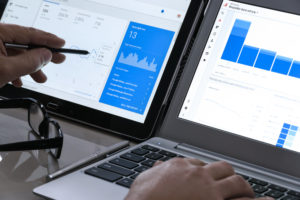Quick Checklist of SEO Fundamentals for Small Businesses

In a small business, every dollar and minute count. You want to make sure you are putting time and effort into tactics and strategies that get results and help achieve business objectives.
As more and more customers seek out answers from the internet, and search engines in particular – 81 percent of shoppers conduct online research before making a purchase – SEO is a strategy that can pay dividends to your business, if you invest your time the right way.
While SEO takes time and effort, there are ways to get started with little upfront cost. Using some of the free tools available, I’ve put together a checklist of SEO fundamentals to get you off the ground. Keep in mind that SEO is an effort that needs consistent attention. Therefore, plan to set aside some time each week or each day to devote to these fundamentals.
Dive into Keywords
At the heart of any SEO strategy has to be keywords. You need to understand how your prospects search on Google when they have a problem or a need. What questions are they asking? What keyword phrases are they typing into the Google search box?
Google’s Keyword Planner is free and a great place to start developing the keyword strategy that will guide your SEO efforts. Although it is designed for Adwords (paid search), it is great for SEO as well. You can also use a free trial a variety of tools, including SEMRush and Wordtracker. The trial period should allow for enough time to complete an initial analysis.
Use these tools to develop a list of the top phrases and/or questions you would like to rank for. Focus on highly specific phrases (3 or more words) directly related to your business.
Develop Quality, Search-Friendly Content

With limited budgets and staff, small businesses need to focus on creating targeted content and improving existing site content. In order to show up in the results for your targeted phrases, you need to have content that is highly relevant to the user search.
The data gleaned from your keyword research is the great place to start with your content development. If you don’t have content that explicitly delivers the answer to the user problem or search, then you have a new content opportunity.
Consider new ways to deliver content beyond basic product or service pages. Blogs have long been an SEO mainstay, but other content assets that showcase expertise, such as a glossary or educational pages with tips and tricks, can drive organic traffic.
Measure and Improve with Search Console
Another valuable (and free!) tool from Google is Google Search Console (formerly Webmaster Tools). It’s a great resource for discovering what keywords are driving organic traffic to your website. To see these insights, under the Search Traffic section, click on Search Analytics. You can look at query data driving to your site going back 90 days. You can look at the site as whole or drill down to specific pages.
Use this data to determine if your site’s content aligns with user search intent and if your priority pages are ranking for important keywords. Identify any underperforming pages; for example, a page that’s getting a good amount of impressions (meaning it is being seen by users in the search results) but not many clicks over to your site.
This could mean that the information the user is seeing – HTML titles, meta descriptions – is not compelling enough, or doesn’t align with what users are looking for. Target these pages for on-page content optimizations to better align the page with search results and/or priority key phrases.
Additionally, this data is a gold mine for determining potential areas for additional content creation. You can identify keywords that you’d like to see perform better. You can also look for ways to improve ranking through optimizing existing content and/or developing new content assets.
Make Friends with Google Analytics

The first stop for any SEO strategy should be Google Analytics. If it’s not already installed on your site, this is a great tutorial video on how to do it. As a free tool, you get a lot of bang for your buck. First, it’s easy to use. Second, it provides great insights into how users are arriving on your site and what they are doing.
Utilize Google Analytics to check organic traffic trends. A weekly check of this data is a window into your site’s overall health and will also give you a chance to identify any concerning trends quickly. For example, a 20 percent drop-off in organic traffic week over week is usually an indication of something going on and bears further investigation.
To see only organic traffic, navigate to Acquisition → Channels → Organic → Select “Landing Page” as “Primary Dimension.” This report contains insights into how users are arriving on your site, and your top landing pages. Spend some time looking at this data, analyzing for trends, patterns, and changes. Look at the performance metrics for your top performing pages, as well as pages you’d like to see do better (i.e. main product or service pages). Make note of these pages; they can be targeted for optimization.
Promote and Engage on Social Media
Social media is not a direct ranking factor for search engines. However, it plays an indirect role in increasing search engine visibility. It also contributes directly to the success of other SEO initiatives. For small businesses, social media can be an excellent way to reach target audiences. It’s also a great way to promote your business and site, as well as make connections with relevant industry publications and influencers.
To start, focus your limited time and creativity on one or two social media platforms that you believe are a good fit for your company. For example, LinkedIn is popular with B2B businesses, while Facebook, Twitter, and Instagram are the top used platforms for B2C.
Completely fill out your profile with relevant information and make an effort to regularly post updates and respond to any comments or feedback.
To take your social presence to the next level, identify a dozen or so social influencers and find ways to engage with them. You can share their content, mention them in a post, or strike up a conversation.
Seek Out Quality and Relevant Links
A critical piece of SEO is building quality links off-site. Having other reputable websites link to you tells search engines and users that your site is trustworthy, relevant and authoritative.
There are many ways to build up your backlink profile, but here are some tips to get you started. Perform a search of your own business to see where your business name is already mentioned on the internet. If a link isn’t included with the mention, reach out to the site owner to thank them for the mention and request if a link can be added. Moving forward, set up Google Alerts for your business name and any other proprietary or trademarked terms to get sent an email anytime these terms are mentioned on the web.
Final Thoughts
SEO can be a valuable tool that can raise your business profile, drive traffic to your site, and ultimately, bring in customers and leads. If your small business clients are new to SEO or could benefit from implementing this channel into their marketing strategy, Boostability can help! There’s no quick way to success with SEO, it takes consistent effort to achieve results.
Boostability has been a leading white label SEO company with partners located worldwide for over a decade. We can certainly help you deliver successful and effective SEO campaigns for your clients! Get in touch with our Partner Success team for more details about our SEO Partner program.
